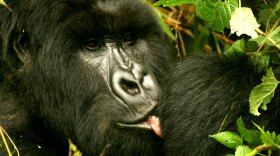Every other Friday, the Outside/In team here at NHPR answers listener questions about the natural world. Today's question comes from Kathryn, calling from New York's Hudson Valley.
"There’s wings in mammals, wings in birds, butterfly wings, bee wings… so many kinds of wings! What makes wings similar and different?
Producer Marina Henke looked into it.
Transcript
This has been lightly edited for clarity.
Marina Henke: I want you to imagine a penguin, but with the wings of a hummingbird. Doesn’t something about that just seem wrong?
What I’m getting at here is that it's fairly easy to intuit some big differences between wing types. But putting your finger – or I guess feather– on what those differences are is a bit harder. May I suggest you start with an open mind towards who exactly has wings in the first place.
Jonathan Rader: I mean, obviously, I think people think of wings and they immediately think of birds and maybe bats…
Marina Henke: This is Jonathan Rader. He studies the physics of how animals fly at the University of North Carolina Chapel Hill.
Jonathan Rader: But it’s not just animals! There are plants that have wings too. Think of a maple seed. If you've ever seen a maple seed, they've got that wing that allows them to spiral down to the ground.
Marina Henke: Plants, insects, extinct dinosaurs… it’s helpful to focus on what’s similar. What do you need to be a wing?
Jonathan Rader: You have to have a broad, flat, maybe slightly curved surface that can catch the air.
Marina Henke: But once that air’s been caught, flight looks all kinds of ways. A flying squirrel glides between treetops, a dandelion seed drifts through the air…
Jonathan Rader: And then we have powered fliers, things like birds and bats that are actually able to flap their wings and generate enough lift to keep themselves in the air as long as they want to stay in the air.
Marina Henke: Many of us have likely been in a different kind of powered flier before… an airplane.
Jonathan Rader: It's a continuum between just slowing down how fast you fall and then basically being able to command your flight and go in the direction and gain altitude and go where you want to go.
Marina Henke: But not all organisms require the same thing to survive. How a creature needs to eat or reproduce or protect themselves… These strategies directly influence their wing shape. For example, let’s compare two types of birds: the sparrow and the albatross.
Jonathan Rader: These two birds have completely different lifestyles, and they fly in very different ways. The albatross is trying to spend as little energy as possible to cross an entire ocean.
Marina Henke: Some species of albatross can spend months or even years at sea – mostly coasting on the wind, rarely even flapping their wings.
Jonathan Rader: This is a seabird and it's got these fantastically long, skinny wings… And so that long, skinny wing shape is really efficient for moving quickly in kind of a single direction not maneuvering very much, but staying in the air for as long as possible.
Marina Henke: Meanwhile, a sparrow needs to be much more agile, maybe jumping into the air to avoid a predator, navigating around thick branches. So their wings are shorter, stubbier.
Jonathan Radar: And so these two different wing shapes are related intimately to the lifestyles of these two different birds.
Marina Henke: With insects, wings diversify even more. That’s because when you're really tiny, the viscosity of the air matters. Basically, it's harder to move through a fluid. And yes, air is a fluid.
Jonathan Rader: Because insects are so much smaller, they have to work relatively harder to move through the same air density.
Marina Henke: Slap the wings of a bald eagle onto a fruit fly and you’ll have a pretty unsuccessful fruit fly. But if you’ve ever spent an afternoon swatting away mosquitoes you could tell me – insects aren’t unsuccessful fliers, their wings just look different from birds.
Take “thrips,” a tiny bug less than a millimeter in size. Their wings look like dozens of tiny hairs. When those filaments catch just enough air… flight.
Like so many things in nature, when it comes to wings, form follows function. From a hummingbird beating its wings 70 times a second, to a butterfly jetting diagonally against the wind, us landlocked creatures get to delight in it all.
For Outside/In, I’m Marina Henke.
Special thanks to Víctor M. Ortega Jiménez.
If you’d like to submit a question to the Outside/In team, you can record it as a voice memo on your smartphone and send it to outsidein@nhpr.org. You can also leave a message on our hotline, 1-844-GO-OTTER.









